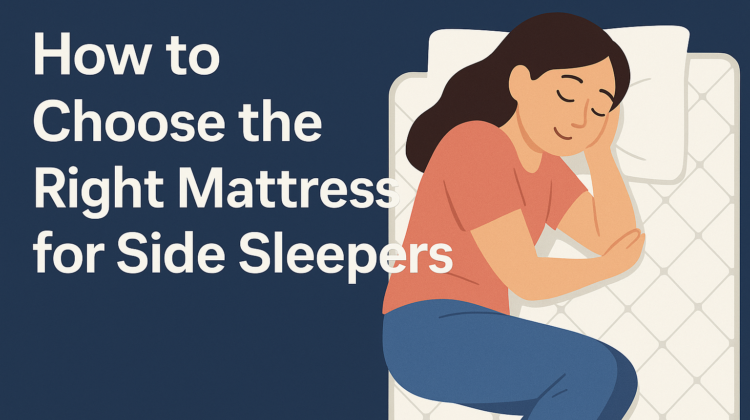
If you sleep on your side and wake up with shoulder or hip pain, your mattress might be the culprit. Side sleeping is the most common sleep position, but it also puts unique pressure on your joints and spine. Choosing the right mattress can be the difference between restful sleep and chronic discomfort.
In this guide, we’ll break down exactly what side sleepers need from a mattress, which features actually matter (and which are marketing fluff), and how to avoid common buying mistakes. Whether you’re upgrading your bed or buying your first mattress, you’ll walk away knowing exactly what to look for.
Why Side Sleepers Need Specific Mattresses
Sleeping on your side concentrates body weight on your shoulders and hips—two areas that are particularly prone to pressure buildup. If your mattress is too firm, it won’t cushion these points, leading to numb arms, joint pain, or lower back strain. If it’s too soft, your spine might curve unnaturally, causing long-term alignment issues.
A mattress that balances pressure relief with spinal support is essential. This often means a softer comfort layer combined with a supportive core—especially if you’re lighter-weight or have joint sensitivity.
Key Mattress Features to Look For
Here’s what truly matters when choosing a mattress for side sleeping:
1. Firmness Level
The ideal firmness for side sleepers typically falls between medium-soft and medium-firm (around 4–6 out of 10 on the firmness scale). This allows your hips and shoulders to sink just enough to maintain spinal alignment without feeling like you’re sinking into quicksand.
Tip: Heavier side sleepers may benefit from a firmer option (6–7) with a plush top layer.
2. Pressure Relief
Look for mattresses that use memory foam, latex, or zoned coils designed to cushion hips and shoulders. These materials contour closely to the body, spreading out pressure and reducing tension.
3. Spinal Alignment
Support layers beneath the comfort foam are just as important. The mattress should keep your spine straight from neck to pelvis, especially when paired with the right pillow height.
4. Motion Isolation
If you share a bed, materials like memory foam and pocketed coils help prevent sleep disruption from your partner’s movements.
5. Cooling Features
Side sleepers often sink deeper into the mattress, which traps more heat. Prioritize mattresses with:
- Gel-infused memory foam
- Perforated latex
- Breathable covers made of cotton or bamboo
6. Edge Support
Good edge support helps if you sleep near the edge or sit on the side of the bed often. Hybrid and innerspring models usually perform better here than all-foam options.
Mattress Types: Pros & Cons for Side Sleepers
| Type | Pros | Cons |
|---|---|---|
| Memory Foam | Excellent pressure relief, quiet, good motion isolation | Can retain heat, may lack bounce |
| Latex | Naturally cooling, responsive, durable | Higher price point, heavier |
| Hybrid | Combines foam and coils for balance | Can be pricier, quality varies |
| Innerspring | Good edge support, breathability | Less pressure relief, may feel firm |
Common Mistakes Side Sleepers Make
Even with good intentions, many side sleepers end up with the wrong mattress. Here are mistakes to avoid:
- Going too firm: Thinking firm = supportive often leads to shoulder and hip pain.
- Ignoring return policies: A mattress may feel great for 5 minutes in a showroom—but your body needs 2–4 weeks to truly adjust.
- Not considering your pillow: A mattress is only one piece of the puzzle. A too-low or too-high pillow can undo good spinal alignment.
Sleep Trial & Warranty Tips
Most top brands now offer risk-free sleep trials ranging from 90 to 120 nights. If you’re buying online, this is essential—your body needs time to adapt.
Check the fine print on:
- Whether returns are truly free
- Warranty coverage for sagging or defects (look for at least a 10-year warranty)
When to Replace Your Mattress
Even a good mattress can wear out. If you notice:
- Visible sagging or lumps
- Waking up sore more often
- Over 8–10 years of use
…it’s probably time to replace it. Memory foam and hybrid mattresses tend to have the most noticeable decline in support over time.
Final Thoughts
For side sleepers, comfort isn’t a luxury—it’s a necessity for spinal health and quality rest. The right mattress cushions pressure points, keeps your spine aligned, and helps you wake up pain-free.
To recap:
- Stick to medium-soft to medium firmness
- Prioritize pressure relief and support
- Choose cooling and motion-isolating features if needed
- Don’t skip the sleep trial
✅ Ready to buy? Check out our hand-picked Best Mattresses for Side Sleepers (coming soon).
